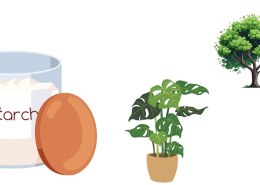Starch is one of the most common forms of carbohydrate in plants, and it plays a crucial role in providing energy for growth and development. It is primarily stored in specific parts of the plant, where it can be accessed when needed for energy or growth. But where does this starch typically accumulate in plants? The main storage locations for starch are in the roots, stems, and seeds of the plant.
The Role of Starch in Plants
Before exploring where starch is stored, it’s important to understand its role in plants. Starch is the product of photosynthesis, a process where plants convert sunlight into chemical energy. During photosynthesis, plants absorb carbon dioxide and water to produce glucose (a simple sugar) and oxygen. The glucose that isn’t immediately used for energy is stored as starch in various parts of the plant.
Starch serves as an energy reserve that the plant can draw upon during times when it is not actively photosynthesizing (for example, during the night or in the winter). It is made up of long chains of glucose molecules, making it an ideal energy storage form for plants.
Where is Starch Stored?
1. Roots
The roots are one of the primary locations where starch is stored in many plants. For example, in tuberous plants like potatoes, starch is stored in the root cells in large quantities. The carrot, sweet potato, and beetroot are other examples of plants where the starch is stored in the root.
In these plants, the root acts as a storage organ that collects and holds starch, which the plant can access when needed for growth or reproduction.
2. Stems
In addition to the roots, stems can also serve as a storage location for starch, particularly in modified stems like rhizomes (underground stems) and bulbs. A notable example of a stem storing starch is the sugarcane plant, where the stems store large amounts of starch.
In some plants, stems are adapted to store starch as an energy reserve during times of dormancy or when conditions are not favorable for photosynthesis.
3. Seeds
Seeds are another key site for starch storage. During the development of seeds, plants accumulate starch to provide energy for the growing embryo when it begins to germinate. Examples of plants with starchy seeds include corn, wheat, rice, and beans. In these seeds, starch is often stored in specialized tissues like the endosperm, which serves as the primary food source for the developing plant embryo.
When the seed germinates and starts to grow, the starch is broken down into glucose, which the embryo uses for energy to fuel its growth.
Why Starch is Stored in These Parts
Roots
- Roots are a natural storage site because they are largely insulated from the outside environment. They can store starch during times of abundance (like during the growing season) and release it when the plant requires energy (for example, in winter or during periods of drought).
Stems
- Modified stems like rhizomes and bulbs provide a stable environment for storing starch. These structures help the plant survive tough conditions by serving as reservoirs of energy. When the plant experiences unfavorable environmental conditions, it can access the starch stored in these structures to continue growth or to survive dormancy periods.
Seeds
- Starch in seeds ensures that the young plant has an energy source when it first begins its growth. Seeds are often dispersed away from the parent plant, and the starch serves as a backup energy supply until the seedling can start photosynthesizing.
Most of the starch in a plant is typically stored in the roots, stems, and seeds. These storage sites allow the plant to reserve energy during times of growth, dormancy, or unfavorable conditions. The ability to store starch in various parts of the plant is a critical adaptation that supports the plant’s long-term survival and reproduction, enabling it to thrive in diverse environments.

